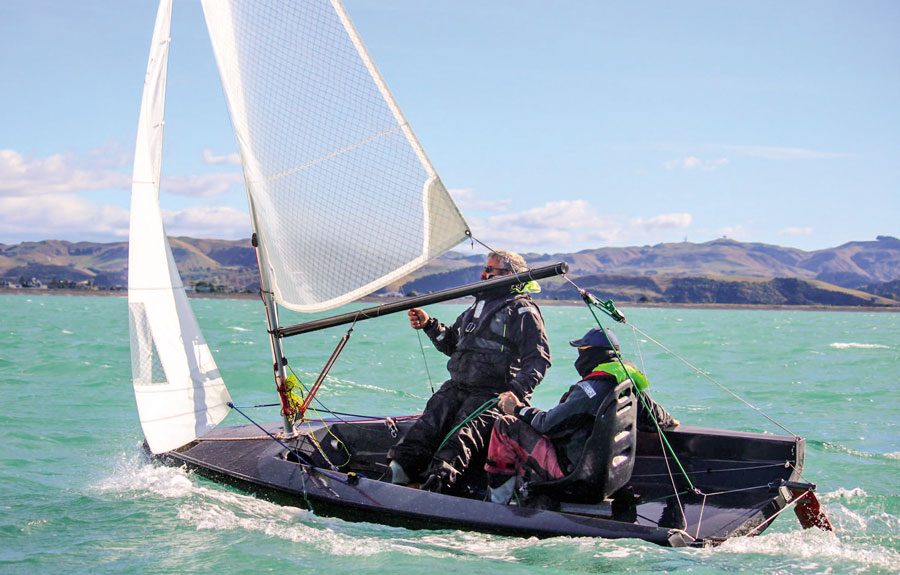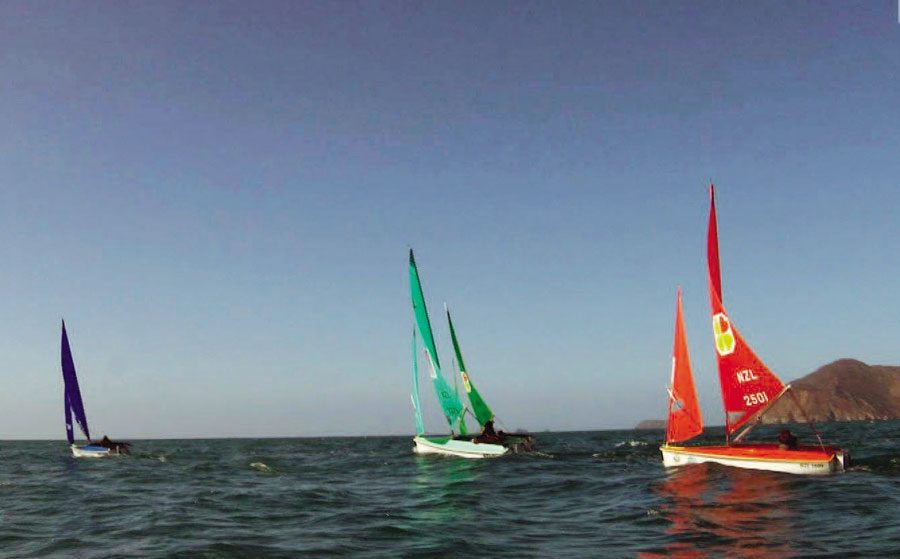

Imagine you and three shipmates take off to sail across the Cook Strait. Each single-handed in a twelve-foot dinghy. On a day the Interislander ferries were cancelled due to rough weather. Ten-metre swells out there.
Now imagine you and your mates are all disabled sailors in some way. Dennis Hebberley is hardlysighted, Katy Moanamika is on the Autism spectrum, two are normally wheelchair-bound, Otis Home with an s-shaped spine of spinabifida myelommeningoceie and Sam Gibson with really brittle bones.
You leave Picton at 7-30am to catch the tide. You arrive at Mana Island Yacht Club at 6pm. Ironically, half the time of the crossing is spent at either end of the voyage, in light, fickle winds.
Your rides are small Liberty class open boats, each ballasted with a 70kg centreboard. Which is a good thing, because none of you can stack out.
All this, after a week cruising these same wee boats in the Marlborough Sounds.
This is just one epic adventure recounted by the staunch sailors of the Napier Sailing Club’s very active Sailability (disabled sailing) contingent. The Cook Strait crossing was six years ago.
Says Dennis, “Time flies when you’re having fun.”
Now Napier’s disabled sailors are evenly divided between those into racing, and those into more adventure sailing of the kind described above. But like all sailors everywhere, racers or adventurers, their time on the water has been curtailed by Covid. They’re all just getting back into it.
Dennis Hebberley says of Sam, he of the brittle bones, “He was absolutely fearless. A great adventurer. Sadly, he died while competing in his wheelchair at the Hastings Marathon, trying to raise money for a child with brittle bones.”
Based at Napier Sailing Club, Sailability Hawkes Bay has a fleet of four Hanse Libertys, designed in Australia, which have mainly been used for one-design racing. The boats carry an unusual rig: what from a distance appears to be a jib is actually a free-standing foresail with a wishbone boom. The mainsail, on its own free-standing mast, has a boom raked upwards, well away from any head-bonking danger. In effect, the Libertys are perhaps the smallest schooners. But their Cook Strait crossing certainly shows the seaworthiness and dash of these small yachts, and their unique design.
Two 303s – dual seat trainers – complement the racing/ adventuring fleet. And just outside their shed there’s New Zealand’s only SV14. It’s a high-tech dinghy of sharp lines and quite some performance. It’s perhaps the future of disabled dinghy sailing. Like the other established disabled sailing dinghies, it also has dual rudders, and a high boom. And a bowlaunched asymmetrical kite.

How it – the design – got here is a circuituous story.
The SV14 originated in Thailand where a group of disabled sailors were on a quest for a competitive but affordable boat. The Dutch design team Simonis-Voogd came to their aid and drew the boat. Later Fareast Yachts in Shanghai committed to building the boats at cost price. The SV14 has now taken off all over the world. The one in Napier, however, was built locally by Paul Freeman.
Besides Hawkes Bay, there are other Sailability outfits in Auckland, Nelson, Otago, Rotorua, Taranaki, Tauranga, Waikato, Wellington and Whangarei, all operating independently under the aegis of Yachting New Zealand.
All Sailability groups in the country have their own Facebook presence.
Most Sailability units offer a pathway into sailing, progressing through training, then individual fleet racing in the 303s and Libertys, then moving on to crewing positions and teamwork in bigger keelboats. There’s much to aim for. Lyttelton Yacht Club’s Andrew May is a world champion disabled sailor in keelboats, and three-times America’s Cup sailor Rick Dodson, now diagnosed with multiple sclerosis, is a great influence here, and has won up large too.
Like Rick, Dennis was a top-end sportsman before, too. A cricketer, basketballer – anything with round balls, in fact. “I started sailing when I Iost my sight. It disappeared overnight. I got a virus, and lost the use of one eye. Eighteen months later, I lost the other. That made ball sports impossible. But that doesn’t stop me sailing.”
True to his competitive spirit, on only his second day of yacht racing, he won every race. “I beat all the reps,” he recalls proudly.
At the first American Blind Sailing Regatta Dennis and his crew finished first-equal. They hit on a novel race-winning tactic. In the very narrow channel of the Alameida, California, race course, they could pull off port-tack starts, legitimately claiming the ‘water room’ right in the restricted water(!).
No doubt every Sailability unit has sailors with as much free spirit and firm resolve as them, and the crew at Hawkes Bay.
Sailing away from Napier on our 12m bridge-deck cat, with all comforts provided, we could only marvel at the chutzpah of the Sailability crews. We felt honoured and humbled to have met them. BNZ
WWW.YACHTINGNZ.ORG.NZ/RACING/PARA-SAILING




